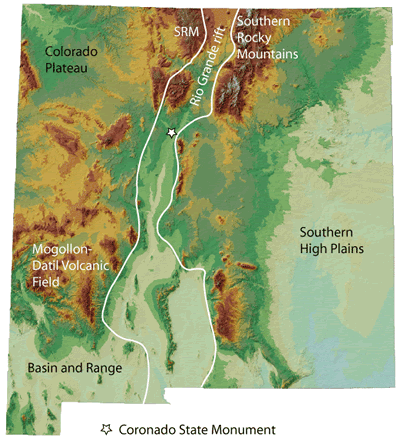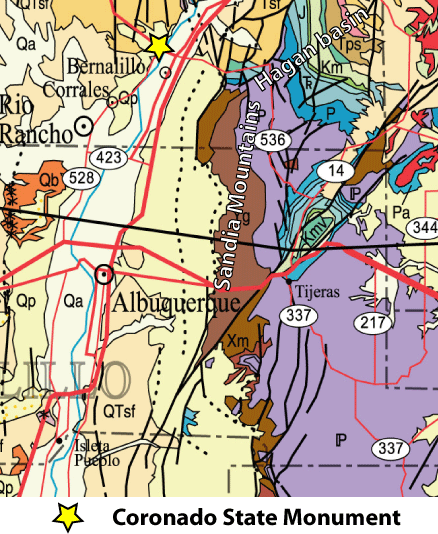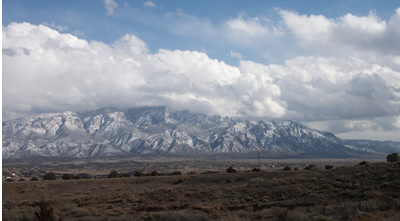
Coronado State Monument
Introduction
Coronado State Monument is located about 15 miles north of Albuqueque in Bernalillo. Drive north on I-25 from Albuquerque, take the Highway 550 exit (Exit 242), drive west 1.7 miles, then turn north (right) on Kuaua Road, following the signs to the monument.
Coronado State Monument is named after Francisco Vasquez de Coronado, a Spanish explorer who was in New Mexico in the mid-16th century. Coronado supposedly wintered at Kuana Pueblo, the large pueblo preserved at the state monument, between late 1540 and early 1541; however, recent excavations indicate that the Spaniards camped nearby at Santiago Pueblo, located about 2 miles to the southwest of Coronado State Monument. Nonetheless, the preserved pueblo is impressive and the kivas at Kuana Pueblo are decorated with remarkable murals that can be viewed at the Visitor's Center.
Geologic Setting

Coronado State Monument, which is on the western bank of the Rio Grande in Bernalillo, offers spectacular views of the Sandia Mountains, a mountain range that exposes one of the most complete records of the geologic history of northern New Mexico (Kelley and Northrop, 1975; Pazzaglia et al., 1999a). Coronado State Monument lies in the Albuquerque Basin (Kelley, 1977), one of several basins that form the Rio Grande rift, a northerly-trending zone of continental extension that runs between central Colorado and west Texas (Figure 1). The dramatic mountains on the east side of Albuquerque, which on average are about 4000 feet higher that the valley, formed as the result of Rio Grande rift extension starting about 25 million years ago (Roy et al., 1999; Karlstrom et al., 1999; House et al., 2003).

The Sandia Mountains dip about 15° to the east. As a result, the oldest rocks in the range are exposed in the western escarpment; the craggy spires on the west side of the Sandia Mountains are made of 1.7 billion year old igneous and metamorphic rocks and 1.4 billion year old granitic rocks (Figure 2). These ancient rocks are overlain by nearly 11,500 feet (3.5 km) of sedimentary and volcanic rocks that are exposed on the east side of the Sandia Mountains and in the Hagan basin to the northeast of the Sandia Mountains. The sedimentary and volcanic rocks, which are are ~330 million to ~30 million years old, tell a tale of oceans rising and falling, great sand dune fields accumulating, and ancient river systems flowing, and volcanoes erupting across the area. Only the oldest rocks near the base of this great stack of sedimentary and volcanic units, the limestones of the Mississippian Arroyo Peñasco Group, and the sandstone, limestone, and shale of the Pennsylvanian Sandia Formation and Madera Group, are visible as a thin, layered, gray band on the skyline capping the pink granitic rocks (Figure 3). These Mississippian and Pennsylvanian rocks were deposited in a shallow ocean that once covered much of the state of New Mexico. More than 1 billion years of Earth's history is missing across the boundary between the pink granite and the gray limestone; this huge gap in the rock record is called the Great Unconformity. The younger rocks of the 11,5000-foot (3.5 km) section, which are not easily discernible from the monument, can be viewed along highways on the northern and eastern side of the Sandia Mountains (Kelley and Northrop, 1975; Pazzaglia et al., 1999b; Lucas et al., 1999; Bauer et al., 2003). These units are discussed in greater detail in a separate webpage about the Sandia Mountains and Hagan basin.

Coronado State Monument overlooks the modern flood plain of the Rio Grande. The pueblo is built on young, poorly-consolidated deposits of sand, sandy clay, and gravel associated with a broad alluvial fan derived from areas west of the river. Two older deposits are exposed in the banks of the river in the vicinity of the monument. A moderately consolidated deposit of gravel, sand, and minor sandy clay derived from an ancestral Rio Grande (<156,000 years old) overlies a well-consolidated <4 to 6 million year old gravelly sandstone with gravel clasts of red granite, basalt, light-gray tuff, and minor sandstone derived from the northwestern margin of the Albuquerque Basin and eastern slope of the Sierra Nacimiento (Connell et al., 1995).
References
- Bauer, P.W., Lozinsky, R.P., Condie, C.J., and Price, L.G., 2003, Albuquerque: A guide to its geology and culture: New Mexico Bureau of Geology and Mineral Resources Scenic Trips to the Geologic Past #18, 181 pp.
- Connell, S.D., Cather, S.M., Ilg, B., Karlstrom, K.E., Menne, B., Picha, M., Andronicos, C., Read, A.S., Bauer, P.W., Johnson, P.S., 1995 , Geology of the Bernalillo and Placitas 7.5-min quadrangles, Sandoval County, New Mexico: New Mexico Bureau of Mines and Mineral Resources, Open-file Geologic Map OF-GM 2 and 16, scale 1:24,000. (mapped at 1:12,000).
- House, M.A., Kelley, S.A., and Roy, M., 2003, Refining the footwall cooling history of a rift flank uplift, Rio Grande rift, New Mexico, Tectonics, v. 22, no.5, 1060, doi:10.1029/2002TC001418.
- Kelley, V.C., and Northrop, S.A., 1975, Geology of the Sandia Mountains and vicinity, New Mexico: New Mexico Bureau of Mines and Mineral Resources Memoir 29, 136 pp.
- Kelley, V.C., 1977, Geology of the Albuquerque basin, New Mexico: New Mexico Bureau of Mines and Mineral Resources Memoir 33, 59 p.
- Karlstrom, K.E., Amato, J.M., Williams, M.L., Heizler, M., Shaw, C., Read, A., and Bauer, P., 2004, Proterozoic tectonic evolution of the New Mexico region: a synthesis, in Mack, G.H. and Giles, K.A., editors, The Geology of New Mexico: A Geologic History: New Mexico Geological Society Special Publication 11, p. 1-34.
- Karlstrom, K.E., S.M. Cather, S.A. Kelley, M.T. Heizler, F.J. Pazzaglia, and M. Roy, 1999., Sandia Mountains and the Rio Grande rift: ancestry of structures and history of deformation: New Mexico Geological Society Guidebook, 50th Field Conference, p. 155-165.
- Lucas, S.G., Read, A. Karlstrom, K.E., Estep, J.W., Kues, B.S., Anderson, O.J., Smith, G.A., and Pazzaglia, F.J., 1999, Second-day trip 1 road log, Albuquerque to Tijeras, Cedar Crest, and Sandia Crest: New Mexico Geological Society Guidebook 50th Field Conference, p. 27-46.
- Pazzaglia, F.J., Woodward, L.A., Lucas, S.G., Anderson, S.G., Wegmann, K.W., and Estep, J.W., 1999a, Plenary paper - Phanerozoic geologic evolution of the Albuquerque area: New Mexico Geological Society Guidebook 50th Field Conference, p. 97-114.
- Pazzaglia, F.J., Lucas, S.G., Estep, J.W., Connell, S.D., Karlstrom, K.E., Black, B.A., Smith, G.A., Hawley, J.W., Johnson, P., Cather, S., and Stearns, C., 1999b, First-day road log, from Albuquerque to Placita, Hagan basin, and Espinaso Ridge: New Mexico Geological Society Guidebook 50th Field Conference, P. 1-26.
- Roy, M., Karlstrom, K., Kelley, S., Pazzaglia, F., Cather, S., 1999, Topographic setting of the Rio Grande rift, New Mexico: assessing the role of flexural “rift-flank uplift” in the Sandia Mountains, New Mexico Geological Society Guidebook, 50th Field Conference, p. 167-174.
- Wilks, M.E., compiler, 2005, New Mexico Geologic Highway Map: New Mexico Geological Society and New Mexico Bureau of Geology and Mineral Resources, scale1:1,000,000.



